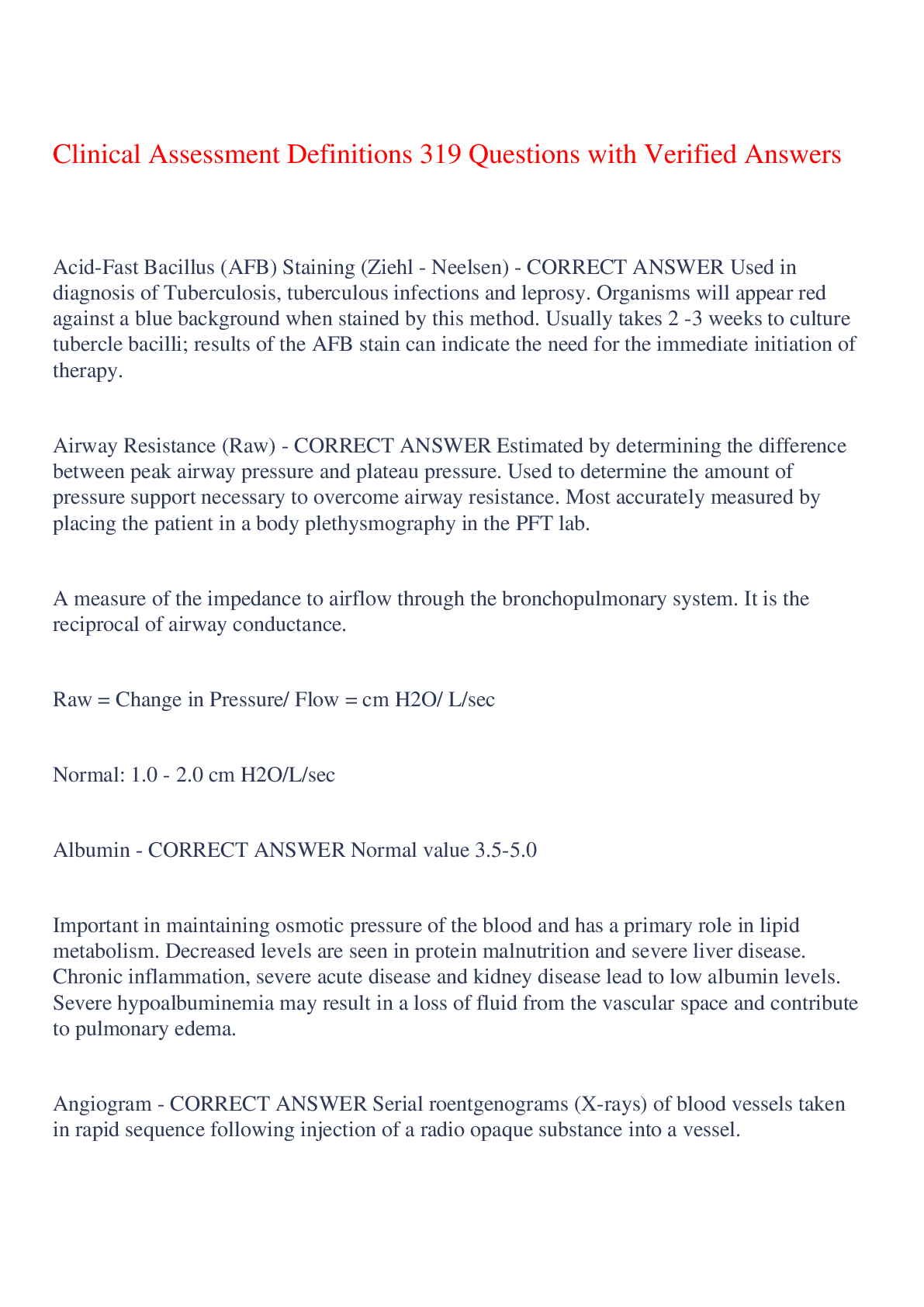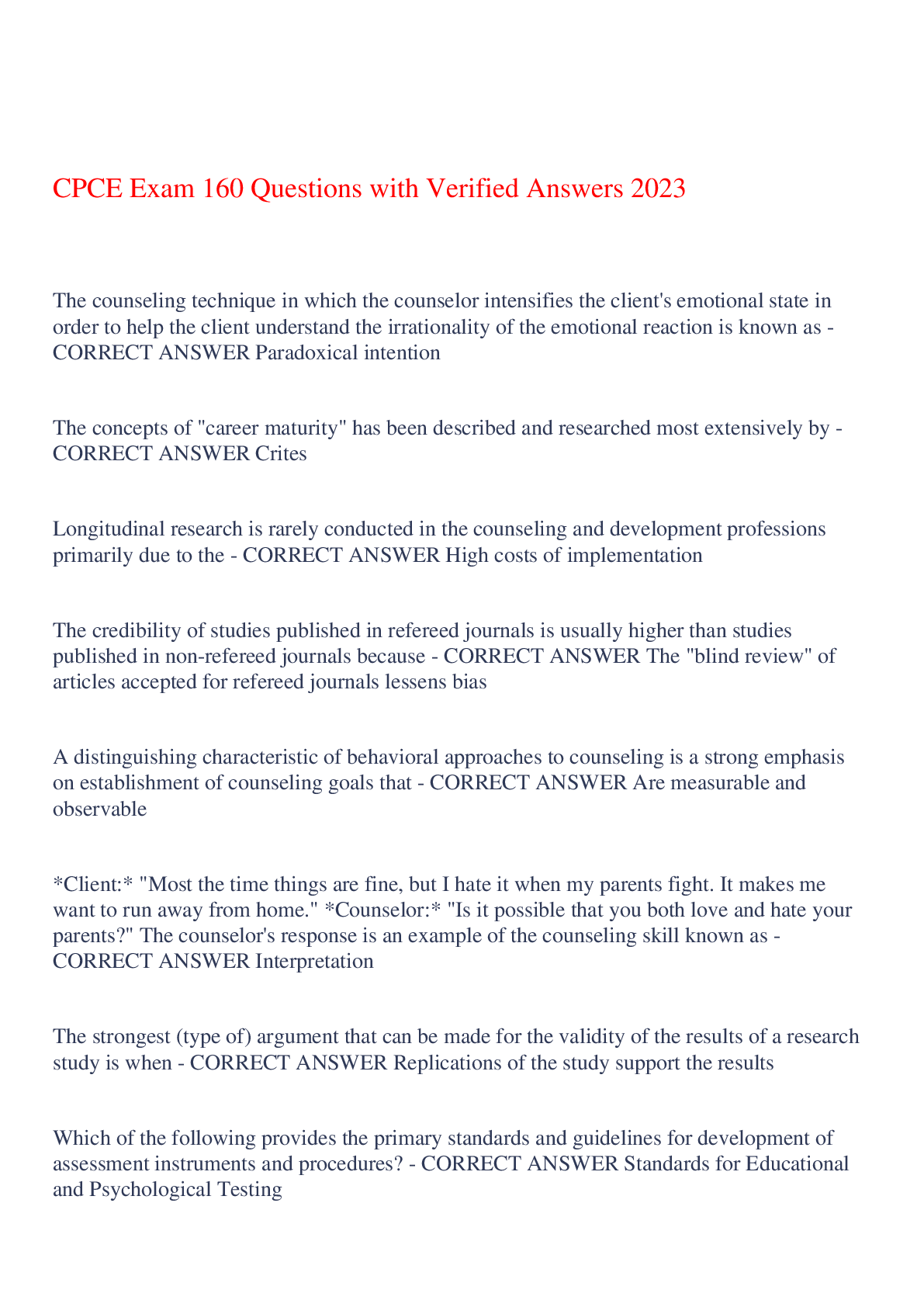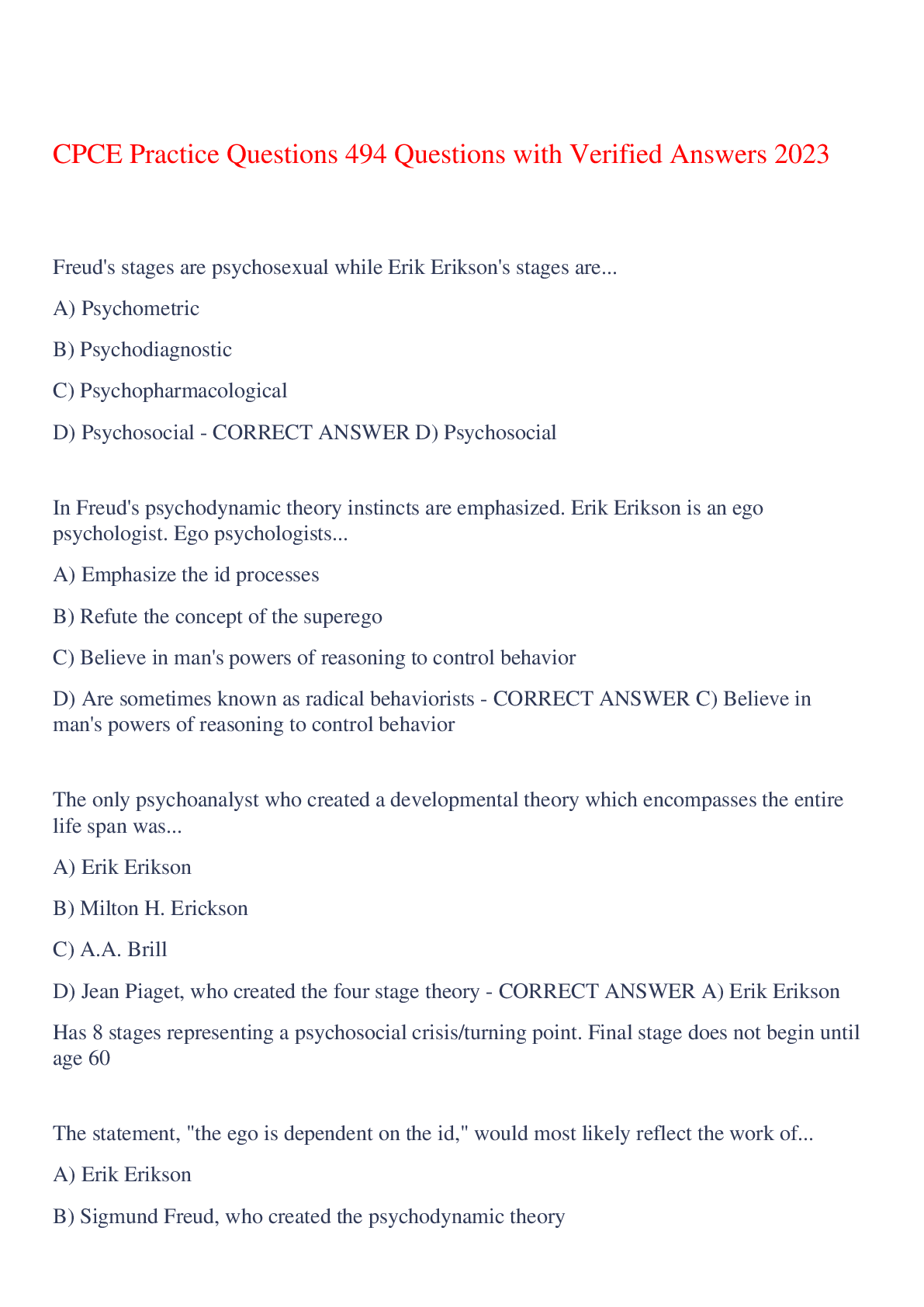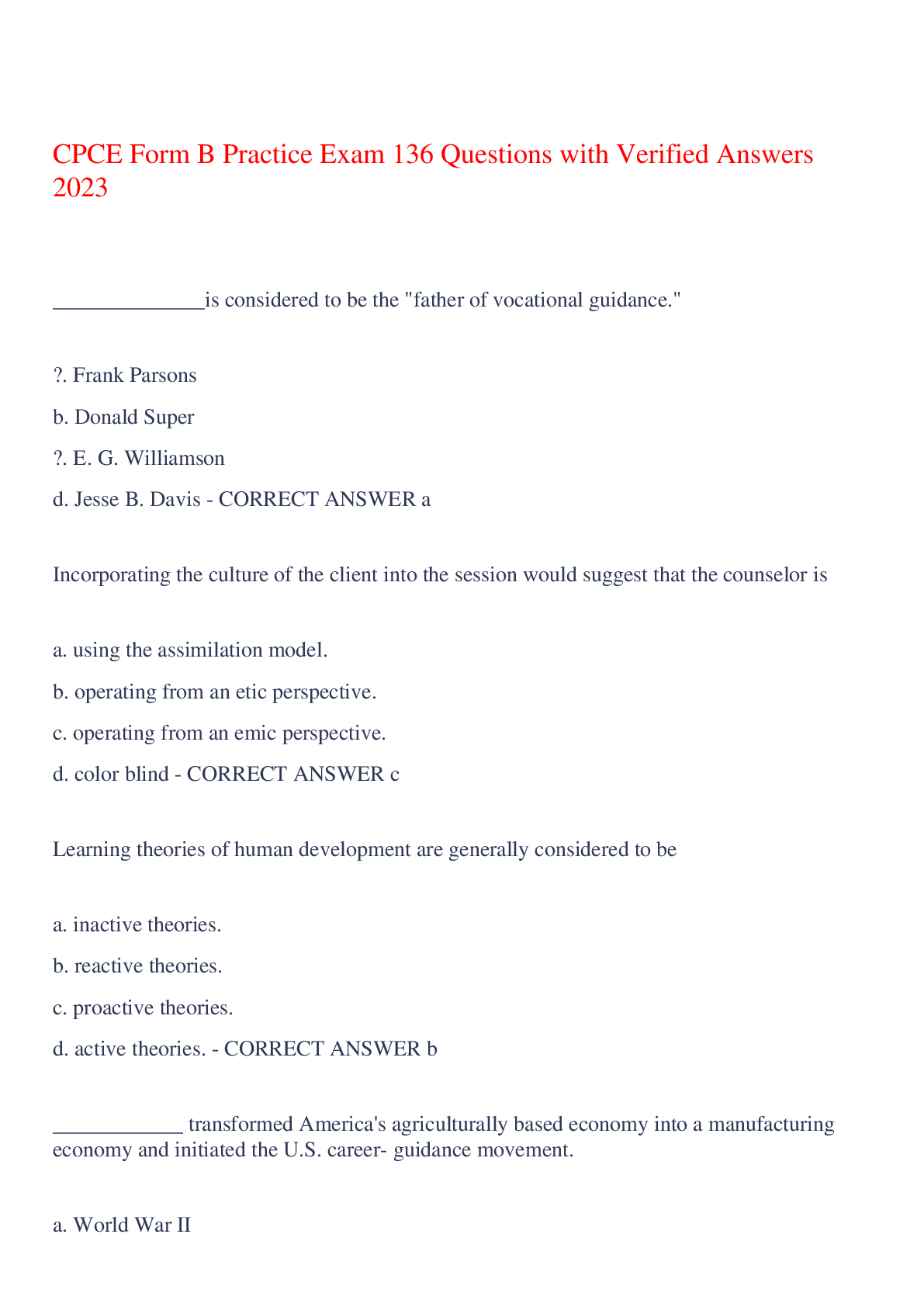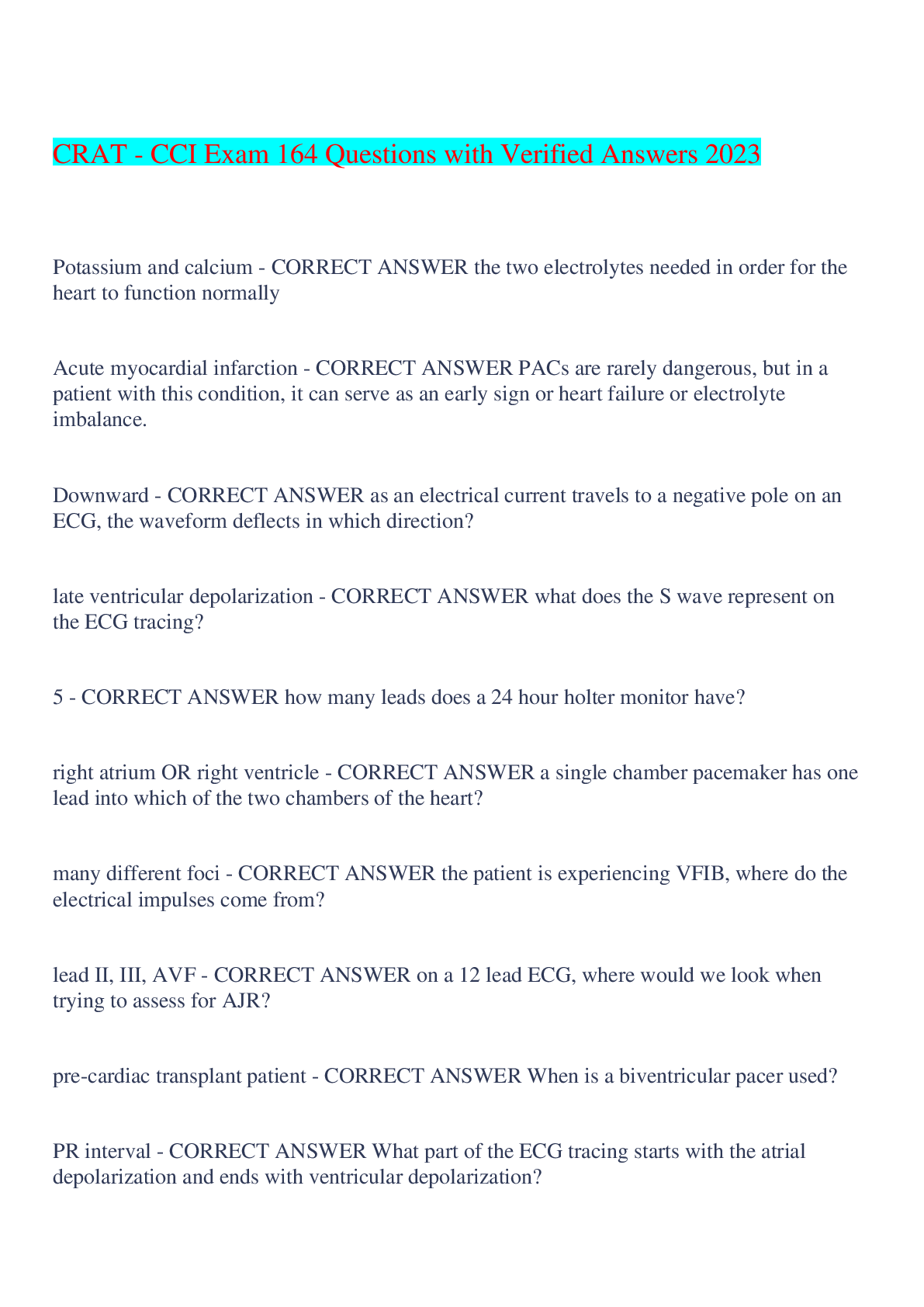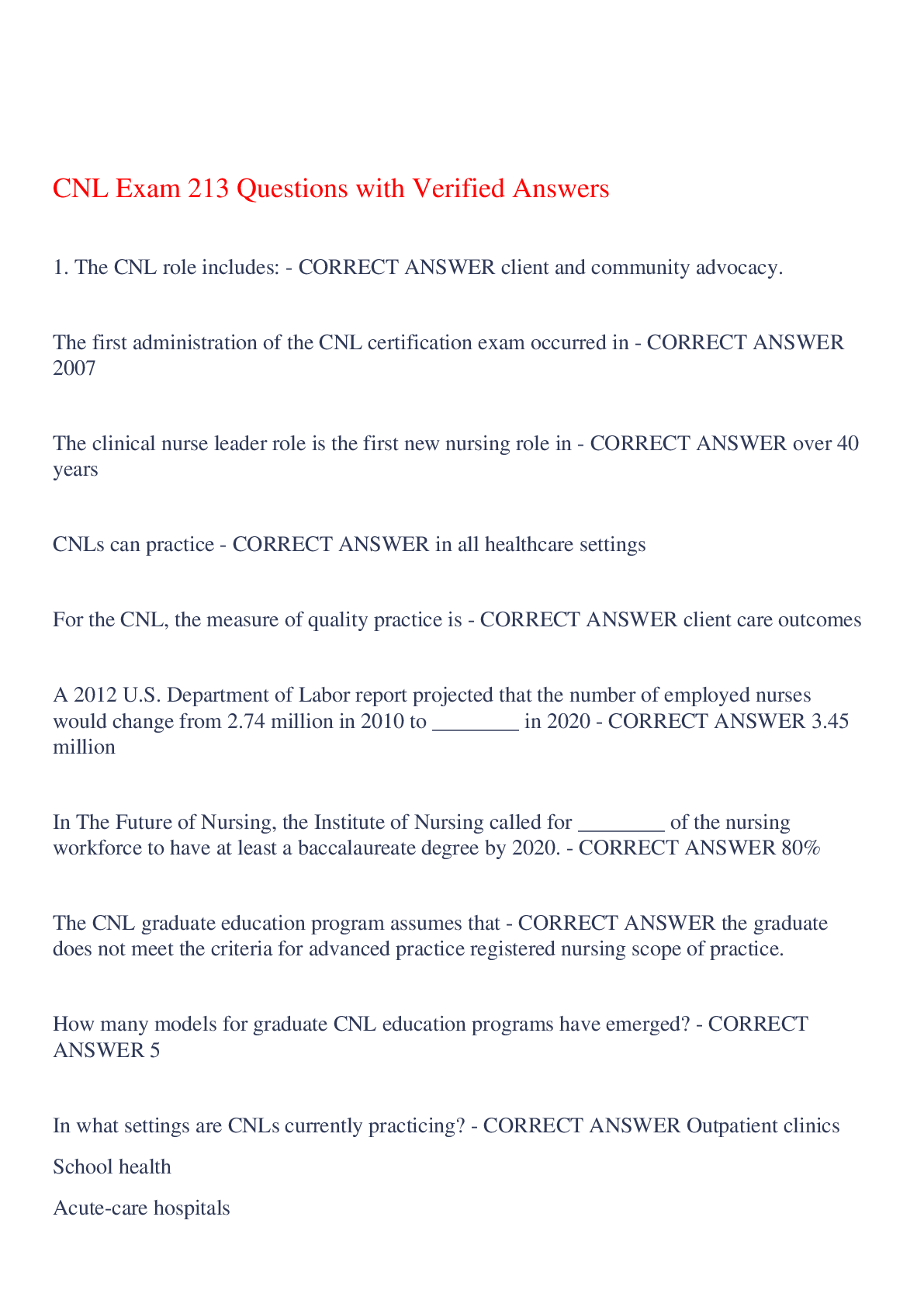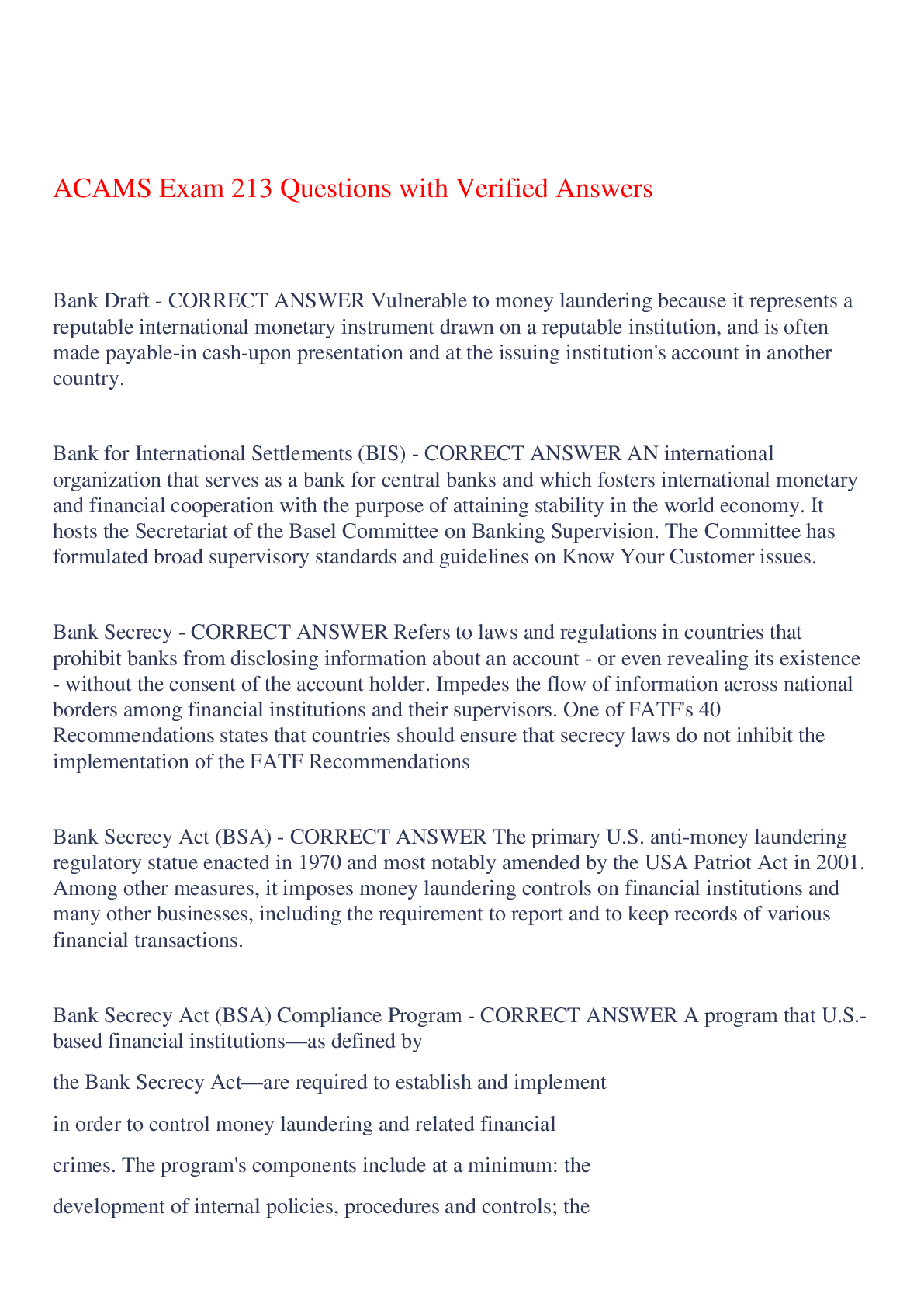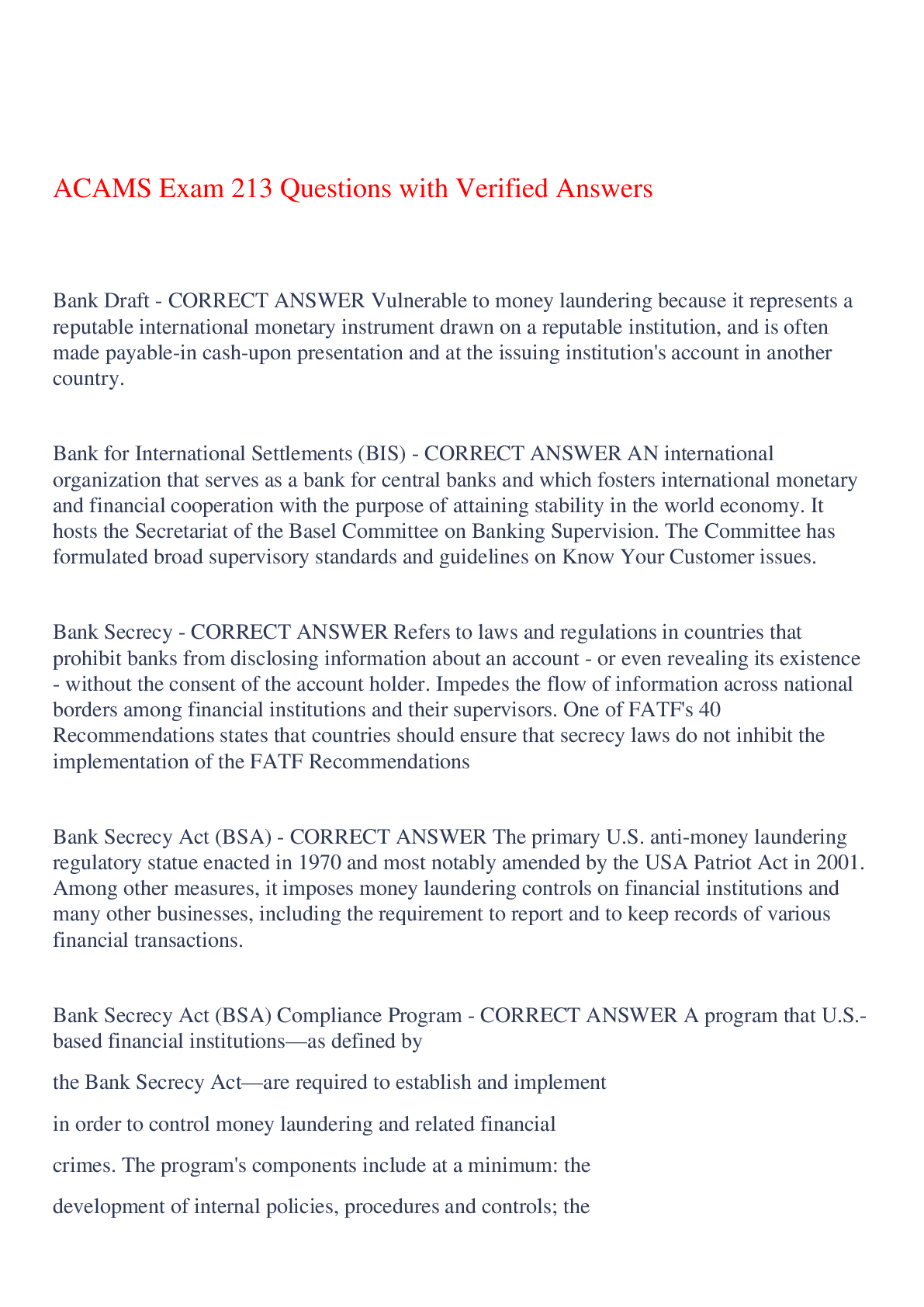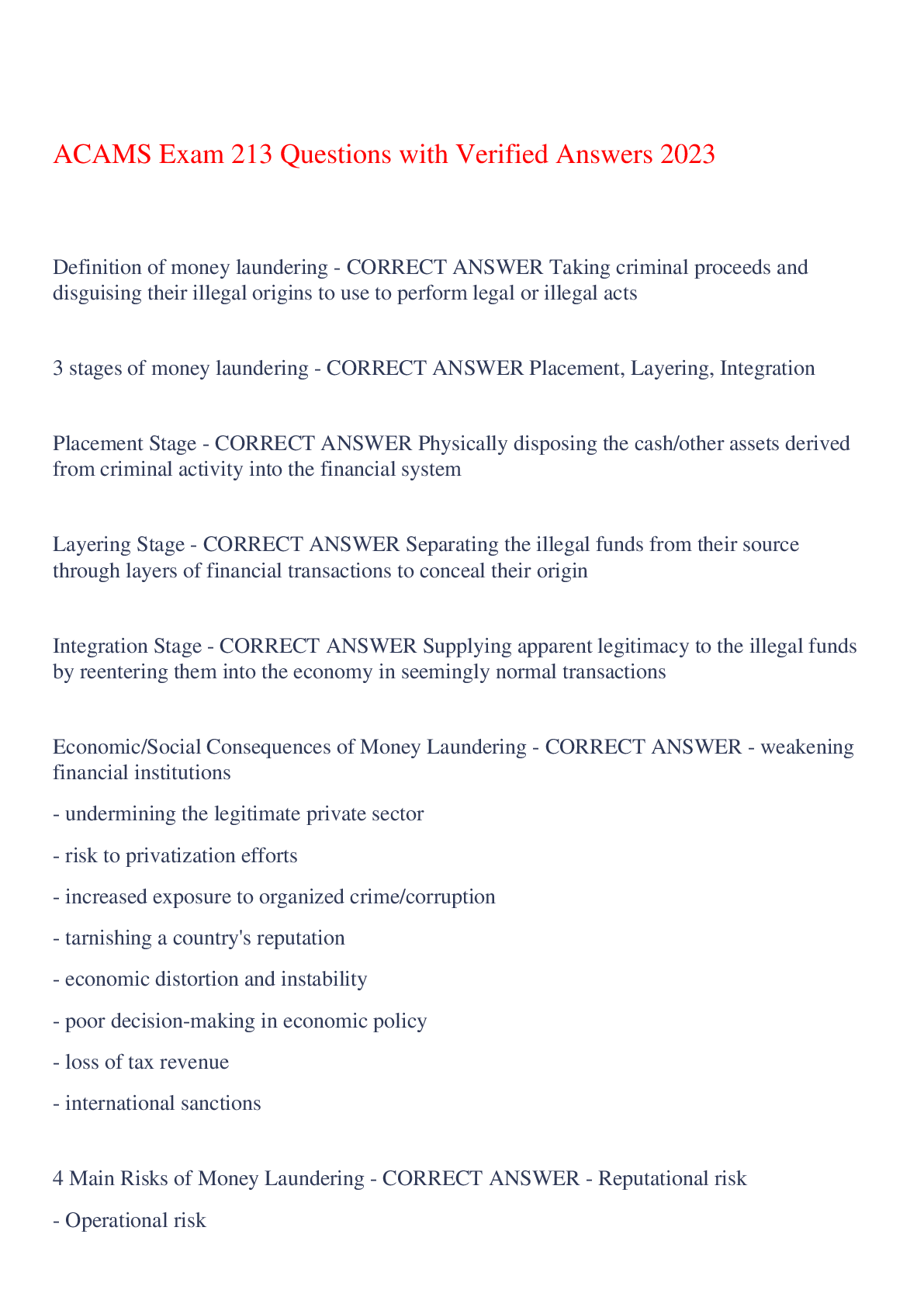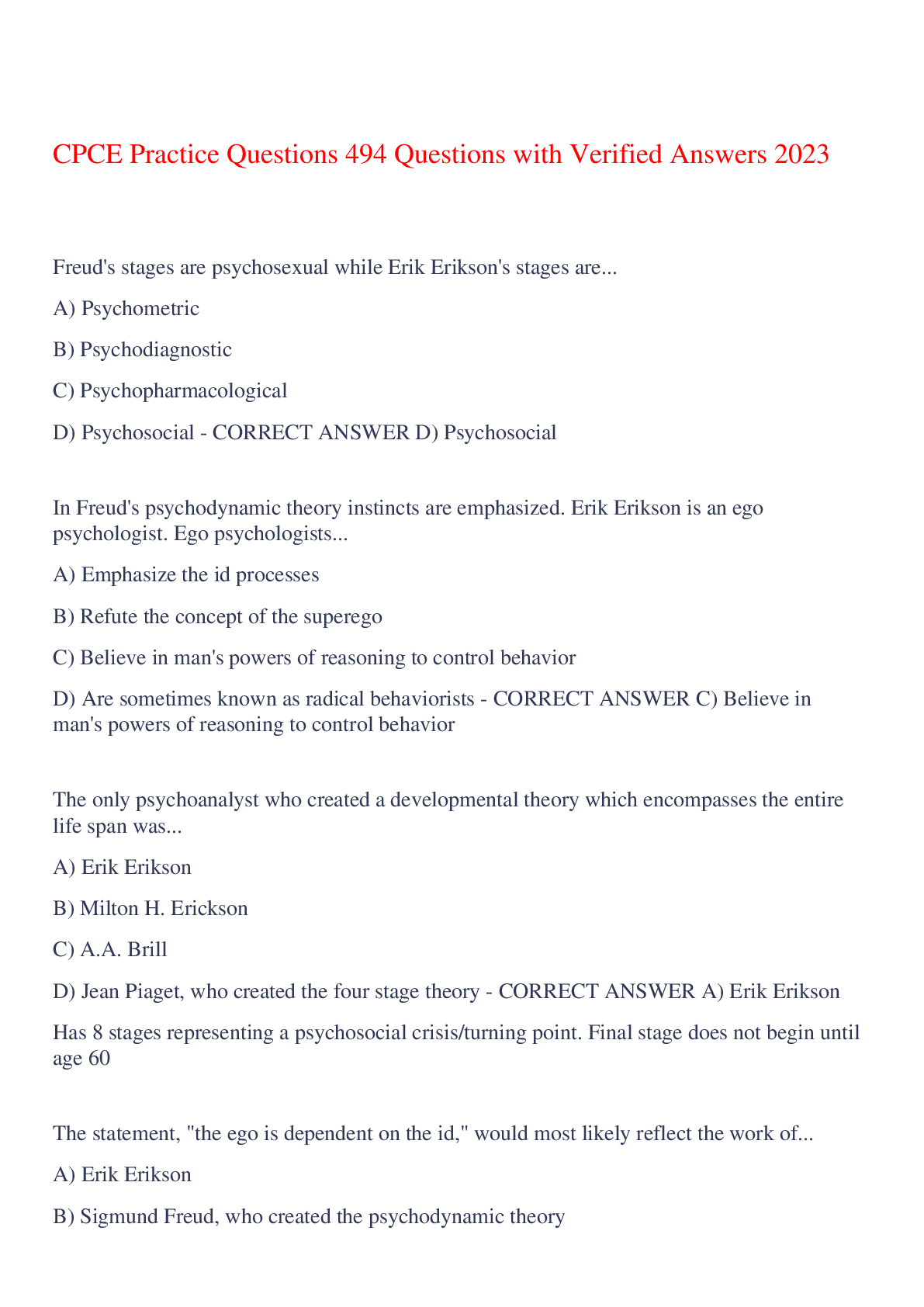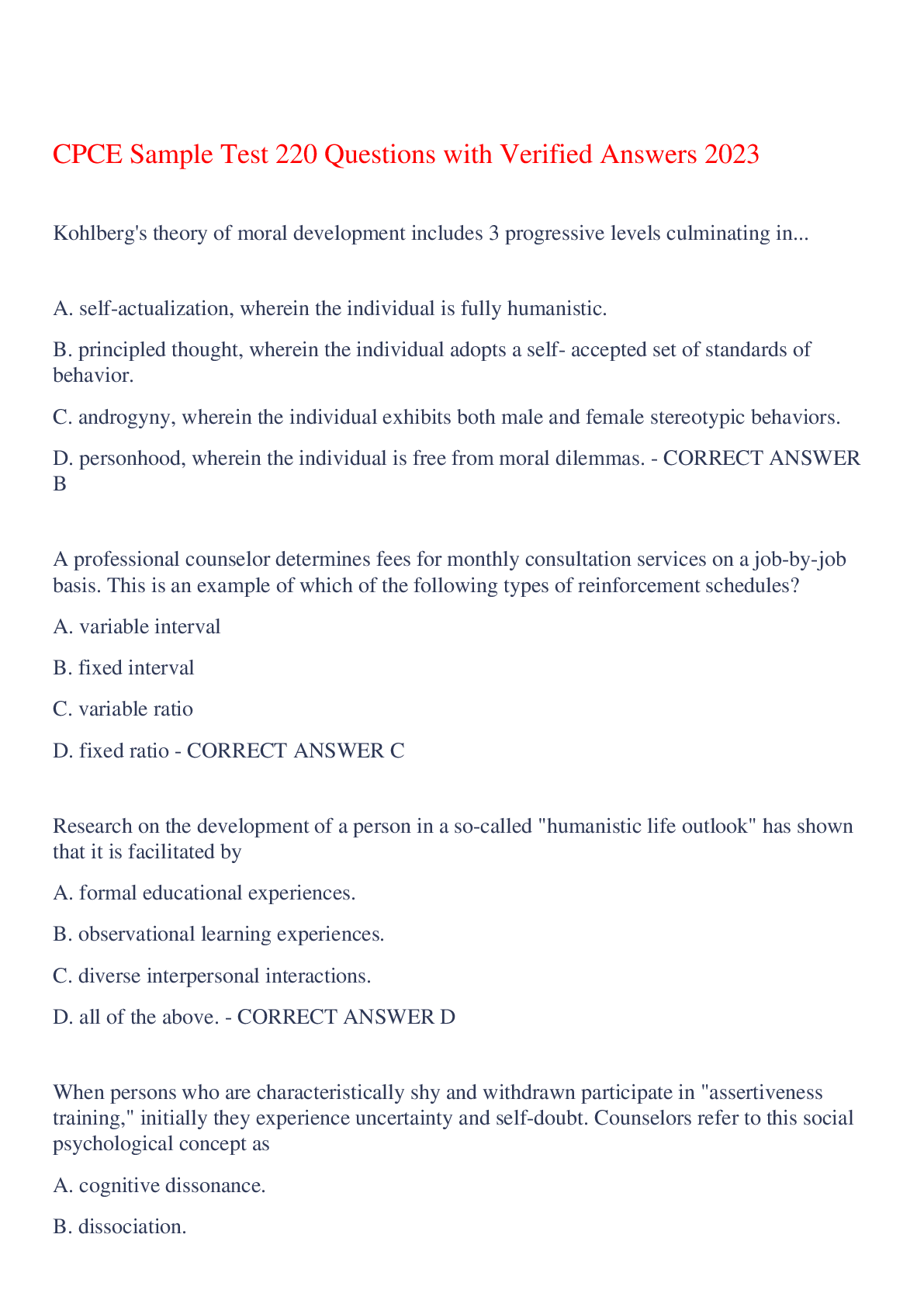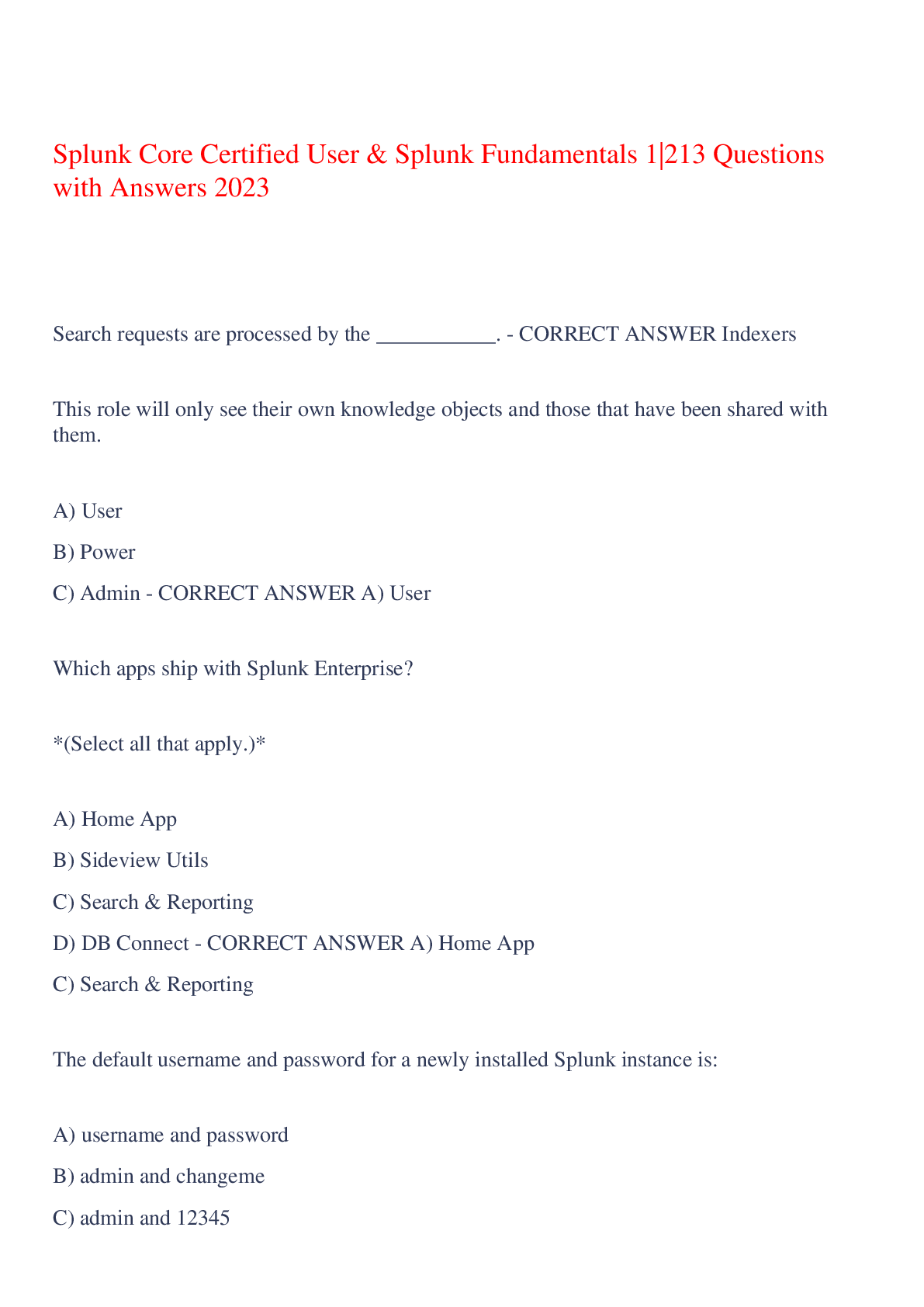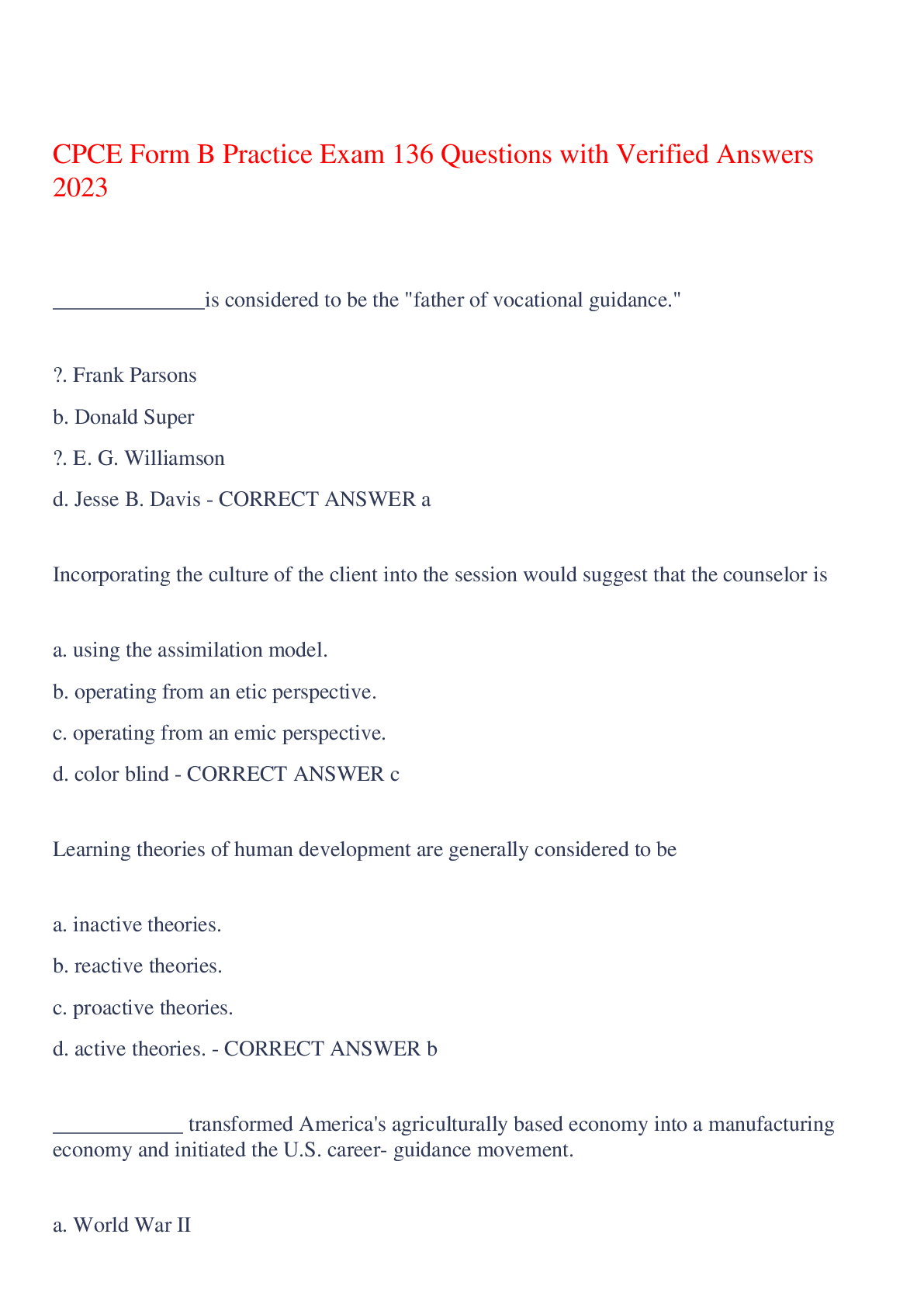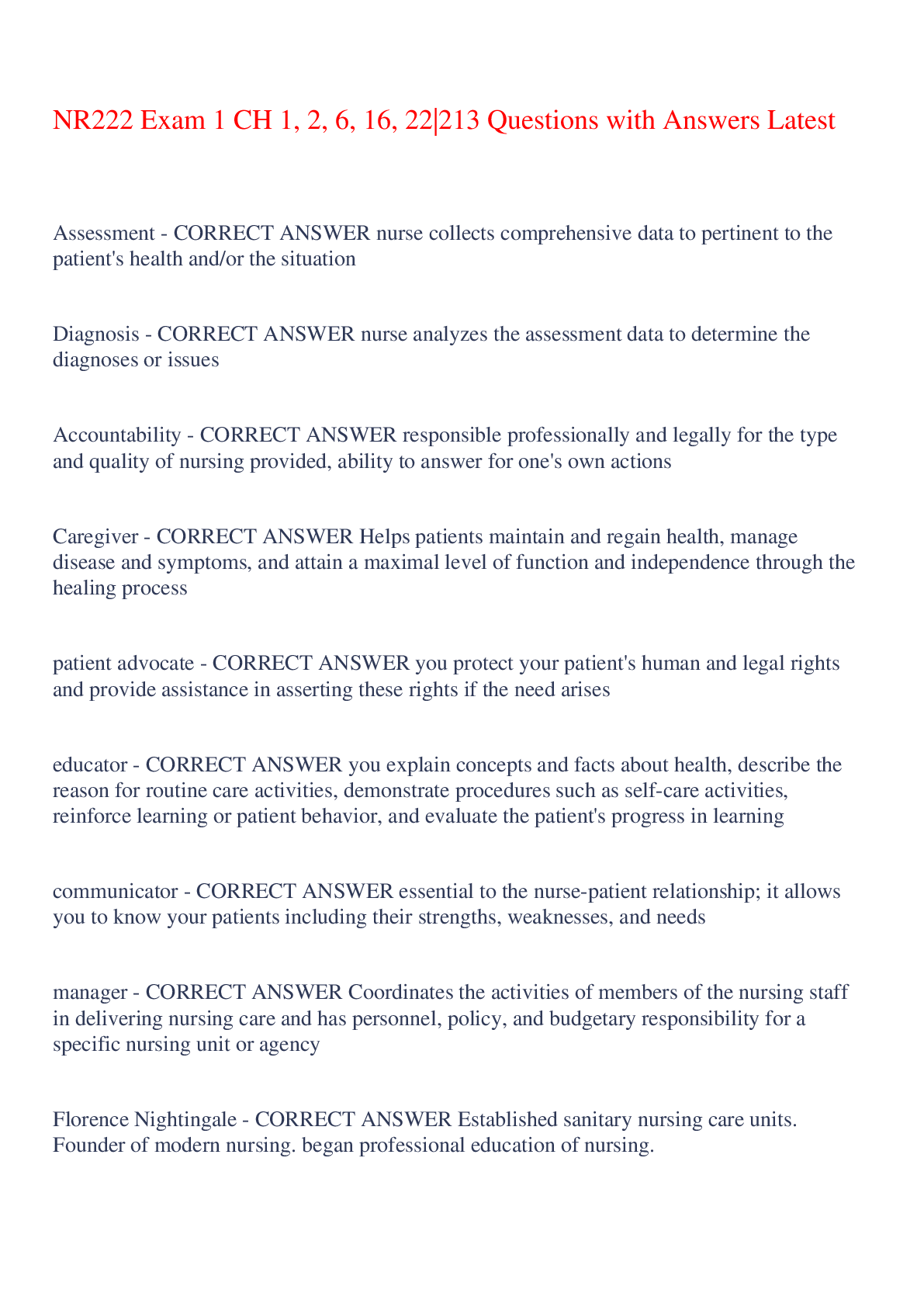ACAMS Exam 213 Questions with Verified Answers 2023,100% CORRECT
Document Content and Description Below
ACAMS Exam 213 Questions with Verified Answers 2023 Definition of money laundering - CORRECT ANSWER Taking criminal proceeds and disguising their illegal origins to use to perform legal or illega... l acts 3 stages of money laundering - CORRECT ANSWER Placement, Layering, Integration Placement Stage - CORRECT ANSWER Physically disposing the cash/other assets derived from criminal activity into the financial system Layering Stage - CORRECT ANSWER Separating the illegal funds from their source through layers of financial transactions to conceal their origin Integration Stage - CORRECT ANSWER Supplying apparent legitimacy to the illegal funds by reentering them into the economy in seemingly normal transactions Economic/Social Consequences of Money Laundering - CORRECT ANSWER - weakening financial institutions - undermining the legitimate private sector - risk to privatization efforts - increased exposure to organized crime/corruption - tarnishing a country's reputation - economic distortion and instability - poor decision-making in economic policy - loss of tax revenue - international sanctions 4 Main Risks of Money Laundering - CORRECT ANSWER - Reputational risk - Operational risk - Legal risk - Concentration risk Concentration Risk - CORRECT ANSWER Potential loss for a financial institution from lending out too much money to borrowers Yates Memo - CORRECT ANSWER Individual accountability for corporate wrongdoing - investigations should not only focus on the corporation, but also the individuals that committed the wrongdoing Senior Managers Regime - CORRECT ANSWER Improve individual accountability within banking by detailing explicit responsibilities for a senior manager to ensure effectiveness of an AML/CFT program Politically Exposed Person (PEP) - CORRECT ANSWER Individual (Foreign or Domestic) who is/was entrusted with a prominent public function - heads of government, senior politicians, judicial or military officials, senior executives of state-owned corps, important political party officials, etc. How long after a PEP leaves office are they still considered a PEP? - CORRECT ANSWER 1 year What measures should be taken to handle a PEP? - CORRECT ANSWER - Check PEP databases to find identifying info - Have senior management approve before establishing any business relationship - Take reasonable measures to understand the source of wealth/funds - Ongoing monitoring Risks of Remote Deposit Capture (RDC) - CORRECT ANSWER - don't have to go to the bank and risk being detected - able to have someone else set up the account for you - fraud risk (minimal human intervention in reviewing/clearing process) Correspondent Banking - CORRECT ANSWER Banks establish relationships with each other in order to undertake international transactions where they have no physical presence Risks of Correspondent Banking - CORRECT ANSWER - one bank carries out transactions on behalf of another, therefore the correspondent bank never verifies the identities of the respondent's customers - large volume of transactions for their customers' customers (harder to identify suspicious transactions) - difficult to determine level of risk when establishing a relationship with a respondent bank (don't know the laws and enforcement of the respondent bank's country) Nesting - CORRECT ANSWER Respondent banks offer their facilities to other institutions downstream, thus further removing the correspondent bank from knowing the identities or activity of the "subrespondents" Payable Through Accounts (PTAs) - CORRECT ANSWER Type of correspondent account where the respondent bank's customers have direct control over funds at the correspondent bank (do not need to clear transactions through the respondent) Concentration Accounts - CORRECT ANSWER Internal clearing accounts established to facilitate the processing/settlement of customer transactions within the bank, usually on the same day. Used primarily for internal administrative or bank-to-bank transactions in which funds are transmitted and commingled without personally identifying the originators. Risk of Concentration Accounts - CORRECT ANSWER If a customer's identifying information is not included in the transaction, then the audit trail is lost Risks of Private Banking - CORRECT ANSWER - perceived high profitability - powerful clients (HNWI, PEPs) - commission-based compensation - secrecy and discretion embedded in culture - less visibility to beneficial owner (PICs) - clients having wealth in various jurisdictions - clients controlling various legal entities Structuring - CORRECT ANSWER Altering a financial transaction to evade triggering a reporting requirement Smurfing - CORRECT ANSWER Making multiple cash deposits (often by multiple individuals i.e. smurfs) in amounts below the reporting threshold Microstructuring - CORRECT ANSWER Splitting up a large transaction into several small transactions, making structuring very difficult to detect How are credit cards used to launder money? - CORRECT ANSWER - Overpaying a credit balance, then requesting a refund in the form of a check (layering) - Using illegal funds in the credit account to buy new goods/services (integration) Third Party Payment Processor (TPPP) - CORRECT ANSWER An entity that contracts with issuing or acquiring banks that helps merchants receive payments online from your customers. This allows merchants to bypass using a merchant account. Risks of Third Party Payment Processors - CORRECT ANSWER - Often not subject to AML/CFT requirements - Multiple financial institution relationships, thus difficult to see the entire customer relationship - Sending funds directly to a bank from a foreign country through an international ACH payment - Large volume of TPPP transactions (hard to detect illegal funds) - High return rates from unauthorized transactions Money Service Business (MSB) - CORRECT ANSWER A business that transmits or converts currencies. Examples include: - Dealing in foreign exchange - Check cashing - Issuing or selling traveler's checks or money orders - Providing or selling prepaid access - Money transmission Risks of MSBs - CORRECT ANSWER - Generally charge lower commission rates than banks, so they're more attractive to criminals - Ability to make money available to criminals at a particular destination country in the local currency - Ability to generate significant transaction volumes outside of banks - quite easy to form Risks of Insurance Companies - CORRECT ANSWER - Channel for criminals to legitimize their funds - Lack of oversight over intermediaries - Policies with payments of cash surrender value - Policies that allow nominee beneficiaries - Sales-driven Examples of Using Insurance for Money Laundering - CORRECT ANSWER - Buying a policy with illegal funds, then changing your mind, cancelling the policy, paying the cancellation fee, then receiving a clean check in return - Buying single premium insurance bonds and redeeming them at a discount (receive a clean check of the balance) - Using a free-look period to back out of a policy with no penalty and getting a check in return - 3rd party funding the policy, probably not subject to due diligence Risks of Securities Broker-Dealers - CORRECT ANSWER - High volume and high speed transactions electronically - Ability to dispose cash through securities purchases - Ability to transfer funds through various countries easily - Easy liquidity, no significant loss of principal - fierce competition and commission-based - Varying levels of AML and due diligence - wash trading Pump and Dump Scheme - CORRECT ANSWER When someone holding a stock artificially drives its share price up by making exaggerated or false reports of its value, then selling the shares (and receiving a clean check in return) Risks of Casinos - CORRECT ANSWER - Extremely cash-intensive - Ready-made excuse for recently acquired wealth - Ability to buy chips with cash and convert them to a check - Ability to use casino credit to layer transactions before transferring money out - Hard to detect money laundering (person may have actually received proceeds from gambling) Risks of Online Casinos - CORRECT ANSWER - Many operate illegally (site regulators are often unregulated offshore firms) - Accounts can be in offshore respondent banks that can be used to conceal ownership of funds - Transactions mainly conducted through credit/debt cards Why gold is attractive to money launderers? - CORRECT ANSWER - High intrinsic value, easy to transport - Can be bought and sold easily and anonymously - Lucrative market How high-value items are used for money laundering - CORRECT ANSWER - False invoicing - Commingling legitimate and illicit funds in diamond trading accounts - Paying someone other than the person selling the goods - Using precious metal pool accounts How is gold used to launder money for drug cartels? - CORRECT ANSWER Drugs from Latin America or Mexico are sold in the US in exchange for US dollars, which are consolidated and smuggled back down to Latin America to buy illegally mined gold in Peru. A front company is created to own the gold and sell it to a US refinery. The US refinery performs a wire transfer to a bank in exchange for the gold and asks minimal questions as to its source. Risks of Art and Antiques - CORRECT ANSWER - Anonymous art agents (ability to conceal ownership) - High intrinsic value, large cash deals How travel agencies are used for money laundering - CORRECT ANSWER - commingling illegal funds with legitimate funds - buying a plane ticket and then requesting a refund - using tour operator networks to falsify bookings and documentation - Paying for trips through structured wire transfers Risks of Vehicle Sellers - CORRECT ANSWER - unreported use of currency to pay for the vehicle - structured cash deposits - vehicle trading to layer transactions - accepting 3rd party payments - Down-trading (trading cars for cheaper models, then receiving the difference in checks) - buying a junker for a low value, then reporting the sale as though it was valuable to commingle the funds Why are gatekeepers (layers, accountants, notaries) attractive to money launderers? - CORRECT ANSWER - can be utilized to enhance secrecy and hide ownership through creating complex legal arrangements or structures or performing transactions on behalf of their client - ability to block or facilitate entry of illegal funds into the financial system - provide a perception of respectability Result of increased awareness of gatekeepers' involvement in money laundering - CORRECT ANSWER Lawyers who represent money launderers can be more easily prosecuted Risks of Real Estate - CORRECT ANSWER - can be bought with cash - easy to hide beneficial ownership - relatively stable and reliable investment - value can increase through renovations Loan-Back Method of money laundering - CORRECT ANSWER Launderer puts the illicit funds in an offshore entity that he owns and then "loans" them back to himself or another company he owns, allowing the launderer to "clean" illicit money and to generate tax benefits by deducting purported interest payments. Reverse Flip method - CORRECT ANSWER Property seller sells a property to a launderer at a below market value, then accepts the difference under the table. In turn, the launderer sells the property at its true value. Using real estate escrow accounts for money laundering - CORRECT ANSWER - ability to facilitate the movement of funds - easy to hide illegal activity (high volume of activity) Free Trade Zone (FTZ) - CORRECT ANSWER a duty-free and tax-exempt geographic area created to attract foreign corporations and create industrial jobs. Typically not subject to customs duty, have poor AML safeguards and minimal oversight. Trade-Based Money Laundering (TBML) - CORRECT ANSWER Hiding and moving illegal funds through trade transactions to legitimize their origins, by lying about the price, quantity or quality of imports/exports Overinvoicing/Underinvoicing - CORRECT ANSWER Invoicing the goods/service for above/below the fair market value Overshipping/Short-Shipping - CORRECT ANSWER Buyer/seller gains excess value based on the difference in the amount of goods invoiced and the actual amount shipped Ghost-Shipping - CORRECT ANSWER Buyer and seller collude to prepare fake trades indicating goods were sold and shipped when none were actually shipped Multiple Invoicing - CORRECT ANSWER Numerous invoices are issued for the same shipment of goods, allowing the launderer the opportunity to make numerous payments and justify them with the invoices Letter of Credit - CORRECT ANSWER Credit instrument issued by banks on behalf of its customer to a 3rd party when conditions are met. It protects the buyer & seller: guarantees the seller will receive payment as long as the delivery conditions are met. Used to finance export, since exporters want to guarantee the buyer will pay. Using letters of credit for money laundering - CORRECT ANSWER - Price manipulation of imports and exports - Used to facilitate a transfer of funds from a country with lax exchange controls, creating an illusion that an import transaction is involved Black Market Peso Exchange (BMPE) - CORRECT ANSWER Money derived from illegal activity in the U.S. is purchased by "peso brokers" from criminals in other countries and often deposited in U.S. bank accounts that the broker has established. The brokers sell checks and wire transfers drawn on those accounts to legitimate businesses that use them to purchase goods and services in the U.S. Inherent risks with new payment methods - CORRECT ANSWER - anonymity - no electronic trail to source of funds - geographical reach - methods of funding (high value limits, reloading capabilities, no limits on amount of cards one can have) - access to cash (ATMs) - segmentation of services (requires multiple parties to execute transactions, limited visibility for banks) - use as a substitute for bulk cash smuggling 3 Segments of Virtual Currency Participants - CORRECT ANSWER - User - Exchanger - Administrator Risk of Virtual Currency - CORRECT ANSWER - No visibility to beneficial ownership and identification of the parties International Business Corporation (IBC) - CORRECT ANSWER Private entity formed outside your country of residence, typically for purposes of confidentiality, asset protection, estate planning, tax benefits, or to serve as holding companies. Risk of International Business Corporations - CORRECT ANSWER Allows you to hide ownership from the offshore entity where the company is registered Bearer shares - CORRECT ANSWER Shares that belong on the surface to the "bearer", so whoever physically holds the shares claims ownership. Typically used for concealing ownership for tax optimization purposes. Shelf Company - CORRECT ANSWER A corporation that has had no activity (created and put on the shelf) How shelf companies are used for money laundering - CORRECT ANSWER A criminal will buy a shelf company to add air of legitimacy, since the company has already been registered, then will backdate certain things to the date the shelf company was created. Shell Company - CORRECT ANSWER A company with no significant assets or operations at the time of incorporation, used to move assets and process transactions through. How shell companies are used for money laundering - CORRECT ANSWER - converting illegal funds into alternative assets - using cash-intensive businesses, creating an illusion that illegal funds are from a legitimate source - concealing criminal ownership by using nominees as owners/directors/shareholders or incorporating in a tax haven with strict secrecy laws How front companies are used for money laundering - CORRECT ANSWER - commingling of funds - complex web of ownership - lending illegal funds between criminally-controlled companies and repaying with interest to avoid suspicion - false invoices and fake expenses - sale of business to create a legitimate source of capital and employment Double Invoicing - CORRECT ANSWER Both companies on either side of a sale of goods are criminally-controlled, and the payment is just a repatriation of illegal money. Risks of Trusts - CORRECT ANSWER - ability to convert illegal funds into less suspicious assets - hides ownership of funds, especially if formed in places with strict secrecy laws - links different money laundering vehicles and techniques (real estate, shell companies, nominees, etc.) - ability to hide assets from legitimate creditors - protects property from seizure Terrorist Financing - CORRECT ANSWER The use of funds for illegal political purpose. The money does not necessarily come from illegal activity, but it benefits the terrorist activity. How do terrorists raise money? - CORRECT ANSWER - social media channels - nonprofit charities - oil trade, extortion, kidnapping for ransom, human trafficking, arms trafficking, racketeering, etc. Emerging risks for terrorist financing - CORRECT ANSWER - raising money through social media - new payment products/services - self-funding by Foreign Terrorist Fighters (terrorist sympathizers) - exploiting natural resources Hawala System - CORRECT ANSWER An international transfer system of exchanging money based on trust relationships between money dealers. A chit, or promissory note, is exchanged between two Hawaladars, and it is as valuable as cash or other traded commodities because the trust between the two parties guarantees its value. Why people use Hawala - CORRECT ANSWER - cheaper and faster - less banking access in certain countries - cultural preference - lack of trust in formal banking system Risks of Hawala - CORRECT ANSWER - no paper trail (no verification or record keeping) - no oversight - can be used to receive illegal funds or operate a front business - can convert funds into any form in different jurisdictions Why nonprofit organizations are attractive to terrorist financing - CORRECT ANSWER - enjoy the public's trust - access to substantial sources of funds - cash-intensive - global presence, especially near areas exposed to terrorism - little to no regulation and oversight (don't always use formal bank accounts) - easy to form Funnel account - CORRECT ANSWER An account in one geographic area that receives multiple cash deposits (below reporting thresholds) from various accounts in other locations. Funds are withdrawn shortly after, in a different geographic area. Financial Action Task Force (FATF) - CORRECT ANSWER Intergovernmental body of 37 member countries and 2 international organizations that sets AML/CFT standards, monitors countries' progress in implementing its recommendations, spreads the AML message globally, and reviews money laundering trends and countermeasures. What criteria is considered to join FATF? - CORRECT ANSWER - Quantitative: size of GDP, banking/insurance/securities sectors, population - Qualitative: impact on global financial system, interaction with international markets, openness, participates in FATF-style regional body, level of AML/CFT risks faced and efforts to combat them Countries with strategic deficiencies related to AML often exhibit... - CORRECT ANSWER - loopholes in financial regulations - obstacles raised by other regulatory requirements (beneficial owner identification, registering business entities) - obstacles to international cooperation - inadequate AML resources Principles of FATF-style Regional Bodies - CORRECT ANSWER - Role (in identifying and addressing AML/CFT needs for members) - Autonomy - Reciprocity - Protection of the FATF brand Main goal of CICAD - CORRECT ANSWER reduce production, trafficking, and use of illegal drugs in Americas Basel Committee on Banking Supervision - CORRECT ANSWER Established by the central bank governors of the G-10, it promotes sound supervisory standards globally for banks and provides a forum for banks to cooperate on supervisory matters Main focus of Basel Committee - CORRECT ANSWER Customer due diligence guidelines (KYC) 4 Key Elements to a KYC Program - CORRECT ANSWER - customer acceptance - customer identification - monitoring (transactions/activity) - risk management (training, audits) 3 Lines of Defense against Money Laundering - CORRECT ANSWER 1. The Line of Business (policies/procedures, screening) 2. AML Compliance function (AML Officer) 3. Audit function (independent, periodic assessments) EU Directives - CORRECT ANSWER Legislation that member states of the EU must issue to prevent their domestic financial systems from being used for money laundering or terrorist financing EU First Directive - CORRECT ANSWER - specified predicate offenses as only drug trafficking - EU law prevails over national law with respect to directives EU Second Directive - CORRECT ANSWER - extended scope of predicate crimes beyond drug trafficking - knowledge of criminal conduct from objective, factual circumstances - more precise definition to money laundering - brought MSBs (bureau de change, money transmitters) under AML coverage - broadened businesses and jobs required to report to authorities (lawyers, accountants, auditors, tax advisers, real estate agents, etc.) EU Third Directive - CORRECT ANSWER (based on FATF's revised Recommendations) - extended scope to trust and company service providers, life insurance intermediaries, and dealers selling goods over 15,000 euros - risk-based approach to CDD - differentiated money laundering from terrorist financing - specific record-keeping requirements - safe harbor immunity - beneficial ownership identification on all accounts EU Fourth Directive - CORRECT ANSWER (repealed previous 3 directives) - decreased reporting threshold from 15,000 to 10,000 - requires countries to hold beneficial ownership info in central registry - extended casino scope to "all gambling services" - CDD for all fund transfers of 1,000 - enhanced due diligence on PEPs (including domestic) - cooperation rules amongst member state FIUs and authorities EU Fifth Directive - CORRECT ANSWER - extended scope of persons subject to AML obligations - greater beneficial ownership transparency (public registers) - coverage on prepaid cards and virtual currency - specified high-risk third countries and high-risk transactions Egmont Group - CORRECT ANSWER Informal networking group of 151 national Financial Intelligence Units (FIUs) to cooperate and combat money laundering and terrorist financing Egmont Group's biggest red flags (100 Sanitised Cases) - CORRECT ANSWER - large-scale cash transactions - unusual fund transfers to/from a foreign jurisdiction - unusual business activity/transactions - large and/or rapid movement of funds - unrealistic wealth compared to client profile - defensive stance to questioning Benefits to money launderers of concealing money laundering within business structures (commingling illicit funds with funds of a front company) - CORRECT ANSWER - more control over the company - fluctuations of business activity draw less suspicion than in a personal account - cash-intensive businesses draw less suspicion for large cash deposits - ability to conceal the link between the criminal and the company through complex ownership structures - minimal cost to form, easy to do Why a criminal would use a legitimate business to launder money - CORRECT ANSWER Criminal funds will be viewed as originating from the firm, not the criminal owner (even if the business doesn't know the criminal source of the funds) Benefits of using false identities, documents or straw men for money launderers - CORRECT ANSWER - separates the asset from the known criminal - illegal assets are owned and handled by individuals with no association to criminality (straw men) - false documentation can help support cover stories Reasons a money launderer would exploit international jurisdictional issues - CORRECT ANSWER - obscures the link between the criminal and the assets - difficult for investigators to be familiar with all jurisdictions - overseas investigations are difficult, costly and slow - criminal can easily move funds cross-border frequently and low cost due to globalization of financial services Benefits of using anonymous asset types to money launderers - CORRECT ANSWER - less audit trail (harder to link criminal to asset) - extremely hard to detect actual ownership or sourcing Examples of anonymous asset types - CORRECT ANSWER - cash - consumer goods - precious metals, jewelry - some electronic payment systems - virtual currency - some financial products (anonymous numbered personal accounts) Wolfsburg Group - CORRECT ANSWER Association of 13 global banks aimed to develop standards on money laundering controls for banks Wolfsburg Group's AML Principles for Private Banking - CORRECT ANSWER - Enhanced due diligence situations - Customer and beneficial owner identification - Customer acceptance - Have at least 1 person other than the private banker approve all new clients and accounts - AML training, record keeping, suspicious reporting - Prohibition of concentration accounts When should you conduct enhanced due diligence? - CORRECT ANSWER - PEPs - high-risk countries - high-risk transactions - correspondent relationships - adverse media on a customer - information gained from transaction monitoring/reporting World Bank - CORRECT ANSWER A specialized agency of the UN that makes loans to countries for capital projects, economic development, trade promotion, and debt consolidation. Provides resources to IMF. Also reviews AML laws and procedures. International Monetary Fund - CORRECT ANSWER UN agency that fosters global monetary cooperation and promotes economic growth and trade by increasing the exchange stability of the major currencies USA Patriot Act - CORRECT ANSWER Law passed after 9/11 that expanded the tools used to fight terrorism (and money laundering), strengthened the Bank Secrecy Act (BSA), and improved communication between law enforcement and intelligence agencies Patriot Act Section 311 - CORRECT ANSWER Gives authority to US Treasury Dept. to designate a jurisdiction, transaction, or account as a "primary money laundering concern", leading institutions to halt banking dealings with the designee and follow measures to ensure compliance. Patriot Act - Primary Money Laundering Concern Due Diligence Measures - CORRECT ANSWER - record-keeping of relevant transactions and identities - beneficial ownership info of foreign-owned US accounts - info on foreign banks' PTA customers - info on foreign banks' correspondent account customers - close certain PTAs or correspondent accounts Patriot Act Section 312 - CORRECT ANSWER Requires due diligence (and in some cases enhanced due diligence) for foreign correspondent accounts and foreign private banking Definition of a private banking account (Private Banking Rule, Patriot Act Section 312) - CORRECT ANSWER - minimum aggregate deposit of $1M - for one or more non-US persons - assigned to a bank employee acting as a liaison with a non-US person Patriot Act Section 313A - CORRECT ANSWER Helps law enforcement locate suspicious accounts or transactions and obtain relevant documents from financial institutions Patriot Act Section 313B - CORRECT ANSWER Encourages financial institutions to share information, with safe harbor immunity protecting them from any liability Patriot Act Section 319A - CORRECT ANSWER Strengthens forfeiture powers over funds of foreign persons/institutions, whereas the US government can seize funds from a US correspondent account opened/maintained by a foreign bank Patriot Act Section 319B - CORRECT ANSWER Forces financial institutions to provide records or information within 120 hours (5 days) relating to AML compliance or an account holder. Also allows for a subpoena of records of a foreign bank with a US correspondent account and requires foreign banks to appoint registered agents to accept the subpoenas. Money Laundering Control Act (1986) - CORRECT ANSWER First criminal money laundering law that is applied if property involved in the transaction represents proceeds from at least one "specified unlawful activity" (SUA). Also covers willful blindness and extraterritorial reach of countries' policies and laws. Office of Foreign Assets Control (OFAC) - CORRECT ANSWER Office within the U.S. Treasury Dept. that administers and enforces economic and trade sanctions against targeted foreign countries, terrorism-sponsoring organizations, terrorists, international narcotics traffickers, and others based on U.S. foreign policy and national security goals. 3 benefits of a risk-based approach - CORRECT ANSWER - flexible - effective - proportionate 3 Categories of Risk for AML - CORRECT ANSWER - Customer Type - Geographic Location - Products/Services Examples of high-risk customers - CORRECT ANSWER - foreign customers - PEPs - those with history of criminal involvement - cash-intensive businesses - complex ownership structures Examples of high-risk businesses/industries - CORRECT ANSWER - casinos - offshore corporations and banks in tax havens - MSBs - virtual currency exchanges - vehicle dealerships - professional service providers (financial liaisons) - high-value item dealers - import/export companies - securities broker-dealers Examples of high-risk jurisdictions - CORRECT ANSWER - countries with poor AML/CFT regimes - countries with sanctions or embargos (OFAC lists) - countries with significant corruption - secrecy havens Examples of high-risk products/services - CORRECT ANSWER - private banking - offshore international activity - anonymous transactions - wire transfer/cash management functions - travelers checks, money orders, official bank checks - loan guarantee schemes - foreign exchange transactions - international remittances - payment services (ACH, prepaid cards) - Payable-Through Accounts (PTAs) Key triggers for reevaluating a customer's risk rating - CORRECT ANSWER - unusual activity or STR filings - law enforcement inquiries (subpoenas) - transactions violating economic sanctions programs - unexpected high volume of activity Four pillars of an AML/CFT program - CORRECT ANSWER 1. System of internal policies, procedures and controls 2. Designated compliance function (with an AML officer) 3. Ongoing training program 4. Independent audit function FinCEN's 6 Guidelines for Strengthening AML/CFT Compliance Culture - CORRECT ANSWER - leadership (BOD) actively supports and understands compliance efforts - no conflicts of interest between compliance and revenue interests - sharing of all relevant information between departments - adequate resources allocated to compliance function - good independent and competent auditor - leadership knows the purpose of AML efforts, how STRs work Main elements of Customer Due Diligence - CORRECT ANSWER - customer and beneficial owner identification (source of funds and wealth) - profiles - customer acceptance - risk rating - monitoring - investigation (of unusual customer/account activity) - documentation (of evidence of actions performed and findings) When to perform customer due diligence - CORRECT ANSWER - before establishing a business relationship - before conducting certain transactions under certain circumstances - if there's suspicion of money laundering - if there's questions about the client's previously obtained identification data Additional information needed for enhanced due diligence situations - CORRECT ANSWER - source of funds/wealth - identification of all parties with control over an account - occupation/type of business - financial statements - banking references - domicile - proximity of residence/business to the bank - primary trade area - anticipated volume of sales, major customers/suppliers - explanations for changes in account activity - approval of senior management to continue relationship 2 types of Persons in opening accounts - CORRECT ANSWER - Natural Persons - Legal Persons/Legal Arrangements Categories of Economic Sanctions - CORRECT ANSWER - Targeted Sanctions - Sectoral Sanctions - Comprehensive Sanctions Targeted Sanctions - CORRECT ANSWER Aimed at specific individuals - freezing assets, travel bans, commodity restrictions Sectoral Sanctions - CORRECT ANSWER Aimed at key sectors of an economy - prohibit specific financial dealings, inhibit future growth within sector Comprehensive Sanctions - CORRECT ANSWER Aimed at regimes that grossly violate human rights or proliferate nuclear weapons - prohibit import/export, trade brokering/financing/facilitation against most goods or services Issues with detecting PEPs - CORRECT ANSWER - lack of available useful information on PEP's identities (no unique identifiers on PEP databases) - some open accounts in names of shell companies or family members in offshore jurisdictions Screening Practices for Know Your Employee - CORRECT ANSWER - check criminal record -monitor social media accounts - enhanced screening (verifying references, experience, education, credit history, etc.) - fingerprint checks for those in sensitive positions - rescreen when person is promoted Goal of a Know Your Employee program - CORRECT ANSWER Understand an employee's background, conflict of interest, and vulnerability to money laundering, as well as to reduce turnover, deter theft/embezzlement and prevent litigation over hiring practices Tipping Off - CORRECT ANSWER Prohibited from disclosing information related to suspicious filing reports to anyone involved in the reported transaction/activity Benefits of automated AML/CFT systems - CORRECT ANSWER - automated customer verification - watch list filtering and screening - transaction monitoring - automated regulatory reporting - case management - audit trail - documentation management Sources of Investigations (by an institution) - CORRECT ANSWER - regulatory recommendations or official findings - transaction monitoring - referrals from client-facing employees - internal hotlines - negative media - government subpoena or search warrant Subpoena - CORRECT ANSWER A court order requiring appearance and/or testimony, and allowing law enforcement to view documents related to suspicious activity Search Warrant - CORRECT ANSWER Allows law enforcement to search a specified premises and seize specified items/documents, based on probable cause (reasonable belief) Key steps in conducting an investigation - CORRECT ANSWER 1. review internal transactions, customer info and related documents 2. identify/review external info about a customer, related entities and media 3. contact business line employees responsible for account relationship 4. document findings What to include in a Suspicious Transaction Report (STR) - CORRECT ANSWER - details of suspicious activity - why you find the activity suspicious Decision factors for closing an account - CORRECT ANSWER - legal basis for account closing - stated policies/procedures for account closing - seriousness of underlying conduct - reputational risk to institution - correspondence with law enforcement Decision factors to prosecute an institution for money laundering violations - CORRECT ANSWER - criminal history - cooperation with the investigation - history of identifying and self-reporting issues - timely and effective remedial action - whether civil remedies are appropriate punishments - advice from regulatory agencies or FIU Useful documents to provide law enforcement in an investigation - CORRECT ANSWER - internal memos - transaction documents - calendars, emails, phone logs - travel records - signature cards - deposit tickets - checks - withdrawal items - credit/debit memos - loan records International Money Laundering Information Network (IMoLIN) - CORRECT ANSWER Clearinghouse of money laundering information for international AML agencies Mutual Legal Assistance Treaties (MLATs) - CORRECT ANSWER Agreement between multiple countries allowing for mutual assistance in legal proceedings and access to documents and witnesses and other legal/judicial resources in the respective countries to use in official investigations and prosecutions. Provides a legal basis for transmitting evidence cross-border. Commission Rogatoire - CORRECT ANSWER Written requests for legal or judicial assistance sent by the central authority of one country to the central authority of another when seeking evidence from the foreign jurisdiction. Specifies the nature of the request, the relevant criminal charges in the requesting country, the legal provision under which the request is made, and the information sought. 3 Functions of Financial Intelligence Units (FIUs) - CORRECT ANSWER - Receive - Analysis - Disseminate Memoranda of Understanding (MOU) - CORRECT ANSWER Agreement between parties to govern their sharing of assets in international asset-forfeiture cases or to set out their respective duties in anti-money laundering initiatives. Used by FIUs to exchange intelligence during investigations Principles of Information Exchange between FIUs - CORRECT ANSWER - Egmont principle of free exchange of information (based on reciprocity) - exchanging info should be quick, informal and secure - no need for intermediaries for communication - respect privacy and confidentiality - differences in the definition of offenses should not be an obstacle to exchanging info Currency Transaction Report threshold - CORRECT ANSWER $10,000 Ponzi scheme - CORRECT ANSWER Tricking investors into investing on the promise of unusually high returns, and using cash from newer investors to pay off prior investors (Bernie Madoff) Front company - CORRECT ANSWER Legitimate company that commingles illegal funds from criminal activity with legitimate funds from selling products/services Examples of structures that hide beneficial ownership - CORRECT ANSWER - shell companies - front companies - buying a company already owned by the criminal - trusts - bearer bonds/securities - money value transfer systems (Hawala) - charities and nonprofit organizations FATF 40 Recommendations Groups - CORRECT ANSWER I. AMl/CFT Policies and Coordination II. Money Laundering and Confiscation III. Terrorist Financing & Financing of Proliferation IV. Financial & Nonfinancial Institution Preventative Measures V. Transparency & Beneficial Ownership of Legal Persons & Arrangements VI. Powers & Responsibilities of Competent Authorities & Other Institutional Measures VII. International Cooperation FATF Recommendations 2003 revision highlights - CORRECT ANSWER - more coverage on terrorist financing - broadening categories of businesses covered - clearer predicate offenses - specific compliance procedures (CDD) - discouraging shell banks - stronger international cooperation FATF Recommendations 2012 revision highlights - CORRECT ANSWER - risk-based approach - designated categories of offenses - knowledge from objective, factual circumstances - When and how to perform CDD - more focus on PEPs - more focus on correspondent banking - more focus on Money Value Transfer Systems - Suspicious Transaction Reporting - greater transparency to beneficial ownership - greater international cooperation - targeted sanctions related to weapons of mass destruction - tax crimes FATF 40 Recommendations - CORRECT ANSWER Detailed list of appropriate AML/CFT minimum standards for countries to implement Money order - CORRECT ANSWER A monetary instrument usually purchased with cash in small (generally under $500) denominations, commonly used by people without checking accounts to pay bills or to pay for purchases in which the vendor won't accept a personal check. They may be used for laundering since they represent an instrument drawn on the issuing institution rather than on an individual's account. Currency Transaction Report (CTR) - CORRECT ANSWER A report that documents a currency transaction that exceeds a certain monetary threshold ($10,000) or multiple currency transactions that occur in one day that exceed the required reporting amount. Cashier's Check - CORRECT ANSWER Check written by a bank on its own funds, often purchased with cash Casa de Cambio - CORRECT ANSWER Currency exchange office (MSB) that offers: - currency exchange and consolidation of small denomination bank notes into larger ones - exchange of financial instruments such as travelers checks, money orders and personal checks - telegraphic transfer facilities Bank Draft - CORRECT ANSWER International monetary instrument drawn on a reputable institution that can be made payable in cash upon presentation and at the issuing institution's account in another country Bank Secrecy Act (BSA) - CORRECT ANSWER A federal law from 1970 requiring that financial institutions take steps to prevent and report cases of money laundering. Benami Account (Nominee Account) - CORRECT ANSWER Account held by one person or entity on behalf of another or others, associated with the hawala underground banking system. Used to move funds through a hawaladar to another jurisdiction and disguise one's true identity or the identity of the recipient of the funds Bill Stuffing - CORRECT ANSWER When a casino customer puts cash in the bill acceptors of various slot machines and collects cash-out tickets with little gaming activity, then cashes out at the casino cage or asks for a check. Affadavit - CORRECT ANSWER A sworn written statement used as the factual basis for an application for a search, arrest or seizure warrant. Asset Protection Trust (APT) - CORRECT ANSWER A tax-neutral, irrevocable trust created offshore to preserve and protect your wealth from creditors Designated Non-Financial Businesses and Professions (according to FATF) - CORRECT ANSWER - Casinos (including Internet casinos) - Real estate agents - Dealers in precious metals and precious stones - Lawyers, notaries, other independent legal professionals and accountants - Trust and company service providers Extradition - CORRECT ANSWER The surrender by one jurisdiction to another of an alleged criminal under an agreement that specifies the terms of such exchange Extraterritorial Reach - CORRECT ANSWER The extension of one country's policies and laws to the citizens and institutions of another Physical presence - CORRECT ANSWER - place of business maintained by a foreign institution - located at a fixed address - employs at least 1 full-time individual there - maintains operating records there - subject to inspection by banking authority Vienna Convention - CORRECT ANSWER 1988 convention against the Illicit Trade in Narcotic Drugs and Psychotropic Substances, committing to criminalize drug trafficking and associated money laundering, and enact measures for the confiscation of proceeds of drug trafficking FATF's Public Statement - CORRECT ANSWER Report issued 3x a year that identifies countries with strategic deficiencies related to AML/CFT and encourages application of counter-measures and enhanced due diligence when dealing with those jurisdictions FATF's report on Improving Global AML/CFT Compliance: Ongoing Process - CORRECT ANSWER Report issued 3x a year that identifies countries with strategic weaknesses in AMl/CFT measures but that have provided commitment to an action plan Responsibilities of an AML Officer - CORRECT ANSWER - ongoing monitoring of AML compliance - sample testing, review exception reports - report to senior management and BOD any noncompliance issues - contact point for all AML issues for internal and external authorities - create training programs - stay current with regulatory/legal changes - be independent from business lines to avoid conflicts of interest Beneficial Owner - CORRECT ANSWER The natural person who ultimately owns or controls an account through which a transaction is being conducted. Has more than 25% control over a legal entity or person. Main points in Wolfsburg Group's guidelines for suppressing terrorist financing - CORRECT ANSWER - official lists of suspected terrorists and relevant info - info on manner, means and methods used by terrorists - standard global formats for fund transfers - safe harbor immunity for employees reporting suspicious activity - enhanced due diligence on high-risk customers and activities International Due Diligence Repository - CORRECT ANSWER Created by Wolfsburg Group and Banker's Almanac to standardize due diligence information. Includes copies of company bylaws, licenses, certificates of incorporation, recent annual reports, info on shareholders, bios of board members/senior management, info about other institutions' AML procedures. What the IMF and World Bank do to help combat money laundering - CORRECT ANSWER - help strengthen financial supervision and regulation in countries - work closely with the OECD and Basel Committee - Promote international AML standards in countries that ask for their financial assistance Report on the Observance of Standards and Codes (ROSC) - CORRECT ANSWER Assessments carried out by the IMF and World bank to examine how well a country observes 12 standards to help them sharpen their discussions with national authorities Differences between policies, procedures and controls - CORRECT ANSWER Policies: high-level uniform statements setting the tone from the top (BOD) Procedures: translates policies into workable practice and responsibilities Controls: tools, technology and alerts to keep the program working as intended What to include in company's policies, procedures and controls - CORRECT ANSWER - identify high-risk operations and provide updates to risk profile - how to inform BOD/senior management of compliance initiatives, deficiencies, STRs - metrics reporting system with stats of the program - assign/establish clear accountability - ensure continuity despite changes in management - role of AML compliance officer - how the company meets all regulatory requirements - dual controls, segregation of duties - screening, training, and disciplining employees - record-keeping practices Information for natural person to provide on account opening - CORRECT ANSWER - legal name - resident address and business address - contact info (phone, email) - date and place of birth, nationality and residency status - gender - occupation, position and employer name - official personal ID # or unique identifier - type of account, nature of banking relationship - signature Documentary verification procedures for natural persons - CORRECT ANSWER - confirm customer's identity from unexpired document with a photo - confirm date and place of birth with official document - confirm validity of official documentation with certification by an authorized person - confirm residential address Non-documentary verification procedures for natural persons - CORRECT ANSWER - contact customer via phone/letter/email confirming account opening - check references from other financial institutions - use independent verification process (public registers, private databases) Information for legal person/legal arrangement to provide on account opening - CORRECT ANSWER - name, legal form status, proof of incorporation - permanent address of principal place of business - identity of authorized natural persons controlling the legal person and all beneficial owners - contact info - official identification number - nature/purpose of activities - financial situation - expected use of account Documentary verification procedures for legal persons/legal arrangements - CORRECT ANSWER - obtain copies of legal documents (certificate of incorporation, memorandum and articles of association, partnership agreement, other relevant docs) - copies of financial statements Non-documentary verification procedures for legal persons/legal arrangements - CORRECT ANSWER - company search/commercial inquiries - independent verification process (public registers, private databases, lawyers, accountants) - obtain prior bank references - visit corporate entity if needed - contact entity by phone/mail Who can impose sanctions? - CORRECT ANSWER - United Nations - European Union - an individual country (ex: the US through OFAC) Types of internal transaction monitoring reports that can help detect money laundering - CORRECT ANSWER - daily cash activity over reporting threshold - daily cash activity just below reporting threshold (structuring) - cash activity over a period of time (structuring) - wire transfer logs - significant change reports - new account activity reports - check kiting/drawing on uncollected funds with significant debit/credit flows Typical STR process - CORRECT ANSWER - procedures to identify suspicious activity through various channels - formal evaluation of each instance - documentation of the decision to file (or not) - procedures to periodically notify senior management or BOD of STRs - employee training Human smuggling - CORRECT ANSWER Illegally transporting someone across international borders in contravention of one or more countries' laws Human trafficking - CORRECT ANSWER Trading humans, typically for sexual slavery, forced labor or commercial sexual exploitation Weaknesses in Free Trade Zones - CORRECT ANSWER - inadequate AML/CFT safeguards - minimal oversight by local authorities - weak procedures to inspect goods - lack of cooperation between FTZs and customs Right of reciprocity (related to international cooperation) - CORRECT ANSWER A rule in the law of a country allowing its authorities to cooperate with other countries' authorities to the degree that their law allows them to do the same Most difficult regulatory challenge facing a foreign financial institution with a correspondent relationship in the US - CORRECT ANSWER USA PATRIOT Act Who is required to approve AML policies? - CORRECT ANSWER Executive management / BOD Who is responsible for receiving and filing STRs? - CORRECT ANSWER The AML compliance officer Best way to establish compliance as a key responsibility for every employee - CORRECT ANSWER Require compliance as a condition of employment Examples of useful metrics for assessing an AML program's effectiveness - CORRECT ANSWER - customer due diligence error rates - quality assurance testing on STR filings - percentage of products/services monitored for suspicious activity What to do when you suspect suspicious activity in a customer's account - CORRECT ANSWER Open an internal investigation, collect appropriate documentation/information, and review it in order to decide whether or not to file an STR Egmont Group working groups - CORRECT ANSWER - Legal - Operational - Training - Outreach - Information Technology What to do if law enforcement urgently requests information on an account - CORRECT ANSWER If the bank has not already filed an STR on the matter, then request that they provide a court order, subpoena or other legal process 3 gateways for international cooperation an sharing - CORRECT ANSWER - mutual legal assistance treaties - exchange of info between FIUs - exchange of info between supervisory authorities What steps to take when there is a criminal investigation targeting your own institution - CORRECT ANSWER - ensure senior management/BOD is notified and kept apprised of the progress - consider retaining outside legal counsel - notify relevant employees and give instructions as to what to do and how to act Primary purpose of requiring information going through a central point within the institution during a criminal investigation - CORRECT ANSWER Ensure that responses are timely and thorough and that privileged material is not inadvertently handed over Key roles of regional FATF-style bodies - CORRECT ANSWER - actively participating in identifying AML technical assistance needs - assisting in FATF mutual evaluation process - publishing periodic typology reports - protecting the FATF brand Factors in determining how/when to report an STR to senior management/BOD - CORRECT ANSWER - if the STR raises significant issues (like reputational risk) - if the STR indicates any compliance deficiencies - if the STR is indicative of any significant AML trends How long must you retain documents for after a customer relationship has ended? - CORRECT ANSWER 5 years FATF transaction threshold for CDD - CORRECT ANSWER 15,000 [Show More]
Last updated: 7 months ago
Preview 1 out of 35 pages

Reviews( 0 )
Document information
Connected school, study & course
About the document
Uploaded On
Sep 03, 2023
Number of pages
35
Written in
Additional information
This document has been written for:
Uploaded
Sep 03, 2023
Downloads
0
Views
144
















